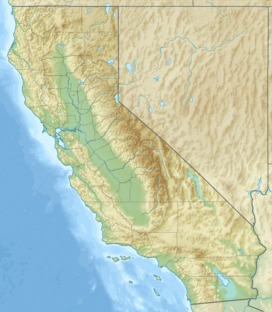Crescenta Valley facts for kids
Quick facts for kids Crescenta Valley |
|
|---|---|

The Crescenta Valley with the Verdugo Mountains to the left, San Gabriel Mountains to the top, and the Mojave Desert to the very top and top right.
|
|
| Floor elevation | 1,500 ft (460 m) |
| Geography | |
| Location | California, United States |
| Population centers | Districts of Los Angeles, districts of Glendale, La Cañada Flintridge |
| Borders on | San Gabriel Mountains (northeast), Verdugo Mountains and San Rafael Hills (southwest), San Fernando Valley (northwest), San Gabriel Valley (southeast) |
The Crescenta Valley is a small valley in Los Angeles County, California. It sits between two mountain ranges: the San Gabriel Mountains to the northeast and the Verdugo Mountains and San Rafael Hills to the southwest. The valley connects to the San Fernando Valley in the northwest and the San Gabriel Valley in the southeast. A smaller valley called the Verdugo Wash runs through it. Most of the Crescenta Valley is over 1,500 feet (450 meters) above sea level.
Contents
History of Crescenta Valley
For a long time, the Crescenta Valley was a quiet, open area. It was part of large land areas called ranchos during the Spanish and Mexican periods. These ranchos included Rancho Tujunga, Rancho San Rafael, and Rancho La Cañada.
The first American settler arrived in 1871. His name was Theodore Pickens. He settled near where Briggs Avenue is today. Later, in 1881, Dr. Benjamin B. Briggs divided a large part of the valley into smaller pieces of land.
More homes and neighborhoods started to appear in 1913. This was when the Montrose area was developed. After World War II, even more people moved here. Today, the Crescenta Valley is a well-developed suburban area.
How Crescenta Valley Got Its Name
The name "Crescenta" comes from the English word "crescent." It does not come from the Spanish word el creciente. Benjamin Briggs chose the name because he could see three crescent shapes from his home. Or, it might have been because of the valley's own shape.
The first post office opened in 1888. The Post Office added "La" to the name to make it different from Crescent City, California.
Communities in Crescenta Valley
The Crescenta Valley is home to several communities. Some are independent cities, while others are districts of larger cities like Los Angeles or Glendale, California.
- City of La Cañada Flintridge
- Crescenta Highlands (also known as "Glendale Annex"): Part of the City of Glendale
- La Crescenta-Montrose: This area is partly in Los Angeles County and partly in the City of Glendale.
- Montrose: Part of the City of Glendale
- Sunland: Part of the City of Los Angeles
- Tujunga: Part of the City of Los Angeles
- Verdugo City: Part of the City of Glendale
Weather in Crescenta Valley
The weather in Crescenta Valley is usually warmer than areas closer to the coast. In summer, daytime temperatures can be 10 to 15 degrees Fahrenheit (6 to 8 degrees Celsius) hotter. Winters are a bit colder than most other parts of Los Angeles.
It rarely snows on the valley floor in winter, but it can happen. Because the valley is close to the mountains, it gets more rain than many other places in Los Angeles. On average, it rains about 20 inches per year. Most of this rain falls between November and March.


